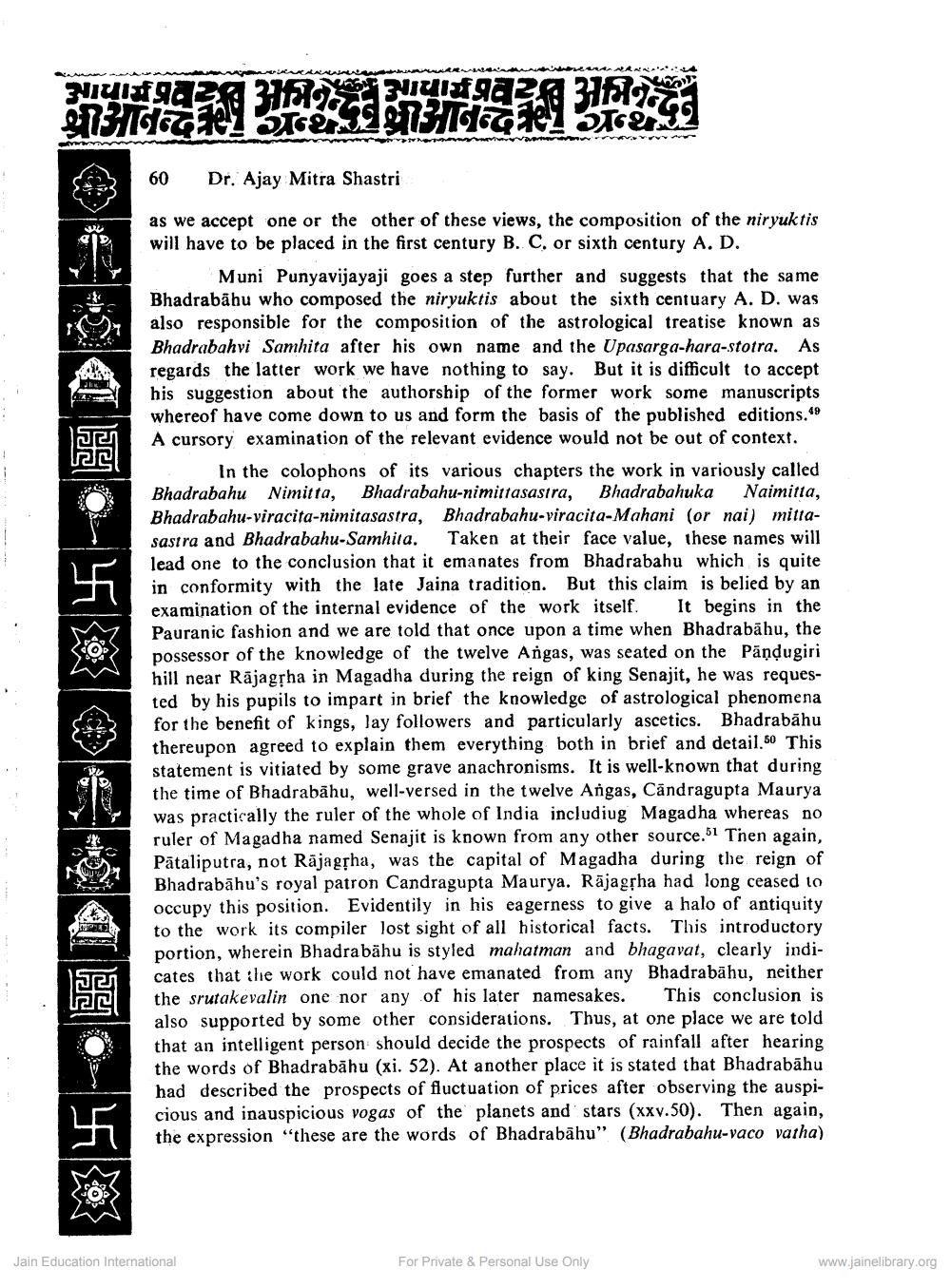Book Title: Varahamihira and Bhadrabahu Author(s): Ajay Mitra Shastri Publisher: Z_Anandrushi_Abhinandan_Granth_012013.pdf View full book textPage 9
________________ SUAMVANNA LALUARGAAN N922 1 2 Buyiga 2A 31 READ 3291BIGGER TO 3 W haver Dr. Ajay Mitra Shastri as we accept one or the other of these views, the composition of the niryuktis will have to be placed in the first century B. C. or sixth century A. D. Muni Punyavijayaji goes a step further and suggests that the same Bhadrabāhu who composed the niryuktis about the sixth centuary A. D. was also responsible for the composition of the astrological treatise known as Bhadrabahvi Samhita after his own name and the Upasarga-hara-stotra. As regards the latter work we have nothing to say. But it is difficult to accept his suggestion about the authorship of the former work some manuscripts whereof have come down to us and form the basis of the published editions.49 A cursory examination of the relevant evidence would not be out of context. in the colophons of its various chapters the work in variously called Bhadrabahu Nimitta, Bhadrabahu-nimittasastra, Bhadrabahuka Naimitta, Bhadrabahu-viracita-nimitasastra, Bhadrabahu-viracita-Mahani (or nai) mittasastra and Bhadrabahu-Samhita. Taken at their face value, these names will lead one to the conclusion that it emanates from Bhadrabahu which is quite in conformity with the late Jaina tradition. But this claim is belied by an examination of the internal evidence of the work itself. It begins in the Pauranic fashion and we are told that once upon a time when Bhadrabāhu, the possessor of the knowledge of the twelve Angas, was seated on the Pāņdugiri hill near RājagȚha in Magadha during the reign of king Senajit, he was requested by his pupils to impart in brief the knowledge of astrological phenomena for the benefit of kings, Jay followers and particularly ascetics. Bhadrabāhu thereupon agreed to explain them everything both in brief and detail.60 This statement is vitiated by some grave anachronisms. It is well-known that during the time of Bhadrabāhu, well-versed in the twelve Angas, Cändragupta Maurya was practically the ruler of the whole of India includiug Magadha whereas no ruler of Magadha named Senajit is known from any other source.61 Then again, Pātaliputra, not Rājagsha, was the capital of Magadha during the reign of Bhadrabāhu's royal patron Candragupta Maurya. Rājagļha had long ceased 10 occupy this position. Evidentily in his eagerness to give a halo of antiquity to the work its compiler lost sight of all historical facts. This introductory portion, wherein Bhadrabahu is styled mahatman and bhagavat, clearly indicates that the work could not have emanated from any Bhadrabāhu, neither the srutakevalin one nor any of his later namesakes. This conclusion is also supported by some other considerations. Thus, at one place we are told that an intelligent person should decide the prospects of rainfall after hearing the words of Bhadrabāhu (xi. 52). At another place it is stated that Bhadrabāhu had described the prospects of fluctuation of prices after observing the auspicious and inauspicious vogas of the planets and stars (xxv.50). Then again, the expression “these are the words of Bhadrabāhu" (Bhadrabahu-vaco vatha) Jain Education International For Private & Personal Use Only www.jainelibrary.orgPage Navigation
1 ... 7 8 9 10 11 12 13 14 15 16 17 18 19 20
